Traditional German Spaetzle Recipe
This post may contain affiliate links. See my disclosure policy.
One of Germany’s most popular and beloved foods, here is a fool-proof and authentic German Spaetzle recipe, just the way my Mutti and Oma made it! Perfect texture and perfect flavor, these are just like you know and love them from the Swabia region of Southern Germany where they originated!
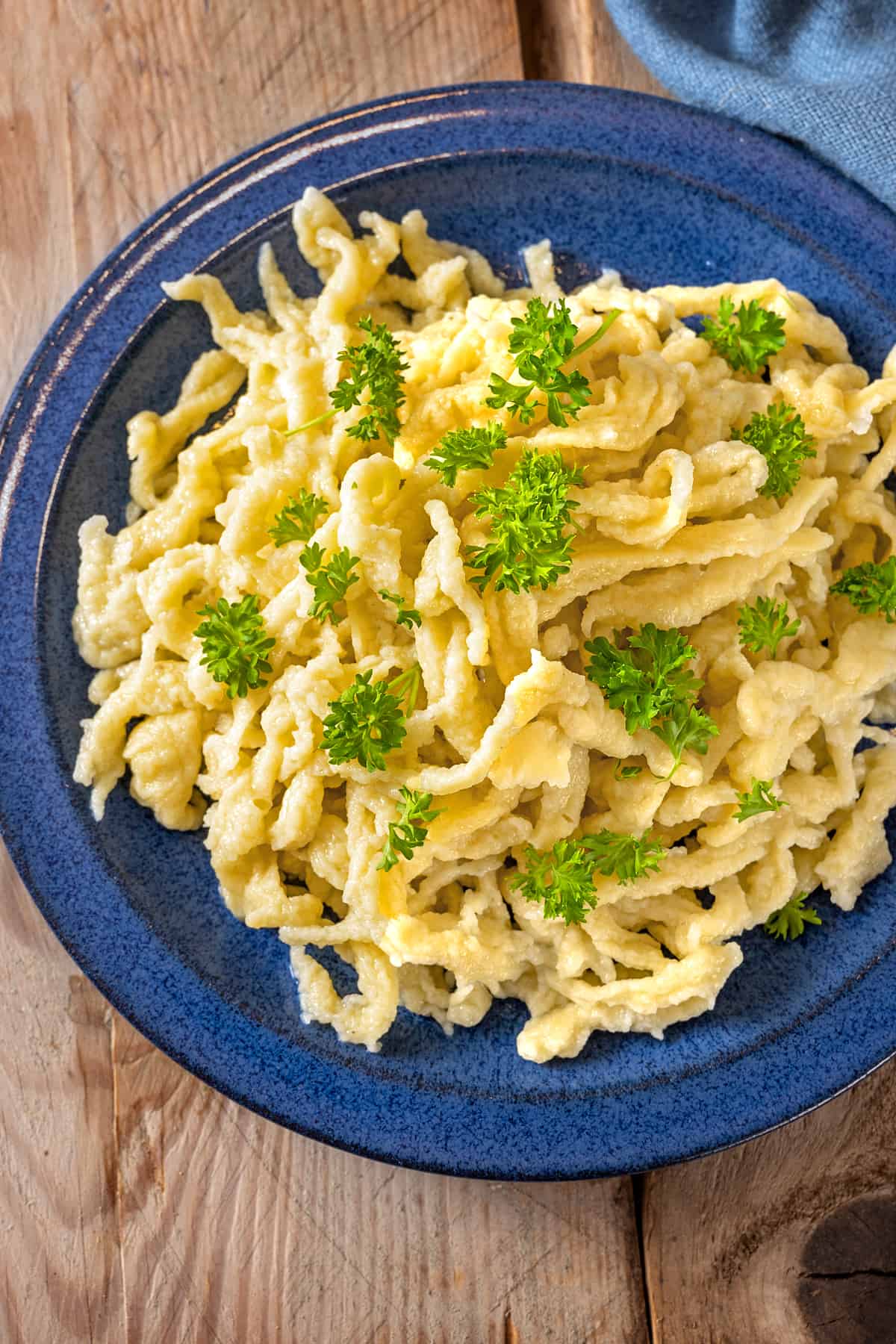
What is Spaetzle?
One of the most beloved foods in Germany that tourists go home talking about is Spaetzle, the famous German egg noodles from the Baden-Württemberg region of southwest Germany. This area is also known as Schwabenland, or Swabia. I grew up in Stuttgart, the capital of Baden-Württemberg, watching my Mom and Oma make Spätzle – I learned from the best!
Swabia is home to some of Germany’s best food (many, including myself, will argue it’s home to the best food in all of Germany). And that’s saying a lot because every region of Germany has amazing food. Swabia is known for its soups, sauces, meats, wursts, and salads, to name a few. It’s also home to some unique varieties of pasta including Spätzle, Schupfnudeln and Maultaschen.
Today we’re featuring Spätzle, a Swabian specialty that is also enjoyed in Austria and Switzerland. Spaetzle is a special type of egg noodle that is enjoyed with sauces and gravies as well as incorporated into a variety of different dishes. One example is Käsespätzle (a cheese spatzle casserole with crispy fried onions). Where did the name “Spätzle” originate? It comes from the German word Spatzen, meaning “little sparrows”, because that’s what they were thought to resemble when they were traditionally made by hand.
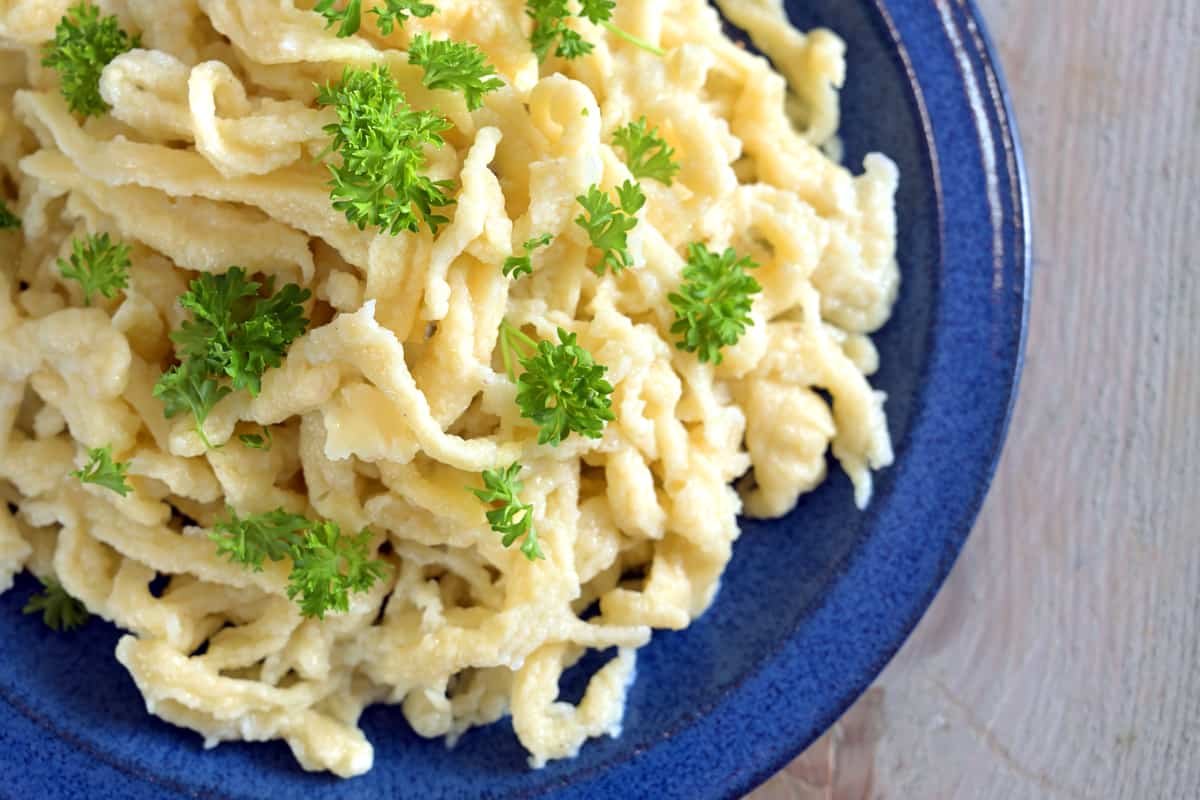
Spaetzle Ingredients
Spaetzle is a type of pasta and as such is made with a very few, simple ingredients that you’ll already have in your pantry. Here’s what you need:
- All-purpose flour: this creates a tender Spaetzle that still has a nice chewy texture.
- Eggs: these add richness and contribute to texture.
- Milk or water: You can use either but I prefer milk as it adds richness.
- Salt: enhances the flavor.
- Nutmeg: this is optional and is not traditional, though many German cooks today like to add it for flavor.
Spaetzle Recipe
Let’s get started!
This spaetzle recipe uses a stand mixer to knead/mix the dough. This is actually the first time I’ve made it that way. I’ve always done it by hand (you “knead” it by vigorously whipping it in a bowl with a spoon – over and over and over for around 20 minutes. It’s a lot of work!) I decided to to try it with a stand mixer instead and it turned every bit as good – and it sure saves a lot of muscle strain!
Add the flour and salt in the bowl of a stand mixer. Stir to combine. Crack four eggs into a bowl and whisk to combine. Make a well in the center of the flour and add the eggs. Add the milk or water and with the paddle attachment (I initially tried the dough hook and it didn’t work well), knead/mix the dough on the “2” setting for about 10 minutes to get a cohesive batter. Add more flour if the mixture is too runny, or more milk if it is too stiff.
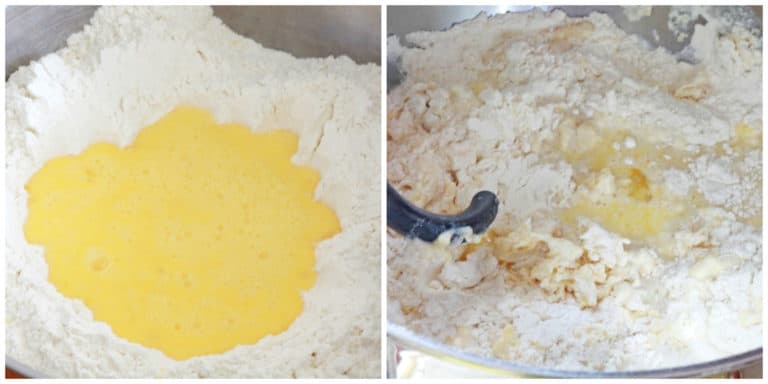
Pro Tip: How to Know When the Spätzle Batter is Ready
The batter is done when “bubbles” begin to form. After about 10 minutes of beating, use a wooden spoon and scoop and pull to stretch the batter; if bubbly holes appear, the dough is done. If not, continue “kneading” with the mixer for another minute or two, repeating the “test” process. See the bubble hole below?
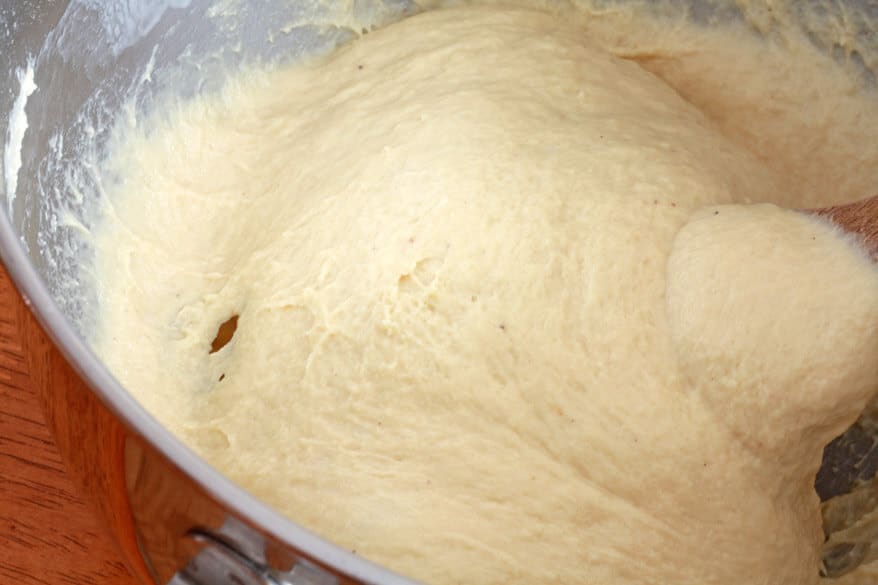
When those bubbly holes start appearing you know your batter is done.
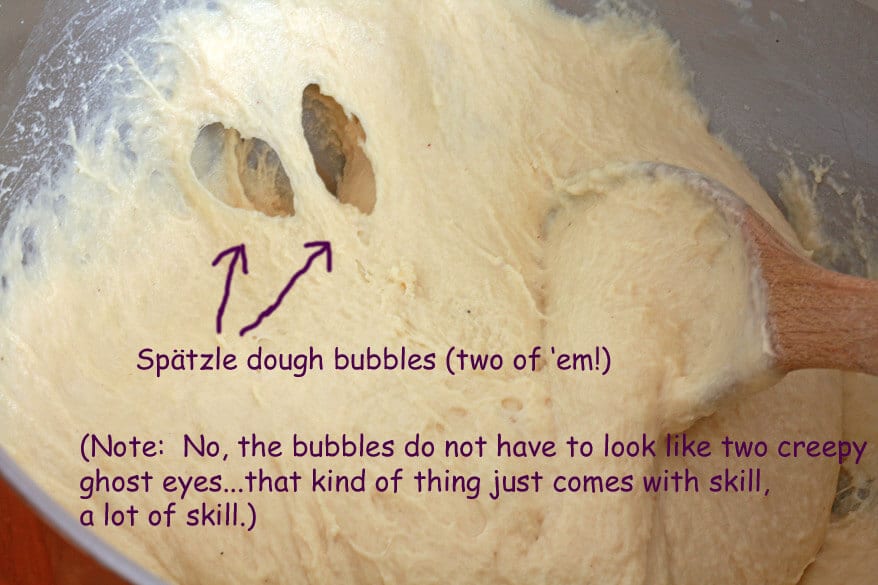
What Is the Best Spätzle Maker?
Now that the batter is read it’s time to make the Spätzle. And when it comes to the Spaetzle maker, there are a few options to choose from. Traditionally, Spätzle was made by hand using a Spätzlebrett, or Spaetzle board. You would rub a slab of dough out onto a wetted board and use a pastry cutter or long sharp knife to quickly cut off strands of the dough into simmering water. Swabian women of previous generations were highly skilled at this and could do it so fast it would make you dizzy to watch. Nowadays most Germans use a Spätzle maker (and even more just buy it ready made at the store. It’s the “convenience generation”).
Besides the traditional Spätzle board there are a few different kinds of Spätzle makers out there that you can find online:
- Spätzle Press (below left): That is my Spaetzle maker that I brought with me from Germany when I moved to the U.S. and it’s awesome. This kind is pricey but it will last a lifetime. It’s called the Original Kull Spätzle Maker and is made in Germany. It’s built like a tank and will become a family heirloom you can pass down for generations. Another brand that is much cheaper and is also made in Germany is this Westmark Spätzle Maker. These Spätzle presses can also be used as potato ricers.
- Spätzle Scraper (below right): Another option is the Küchenprofi Spätzle Lid & Scraper. I’ve used this one as well with good results and it’s much cheaper. It produces a shorter, stubbier spatzle noodle. Alternatively you can also use a metal steamer because it’s similarly constructed with large holes. You place some of the dough in the steamer over the simmering water and scrape the dough through the holes.
- Spätzle Plane: A third option is the Küchenprofi Spätzle Plane with Pusher, which is my least favorite as it can be a little clumsy, messy, and more difficult to work with but I know people who use it.
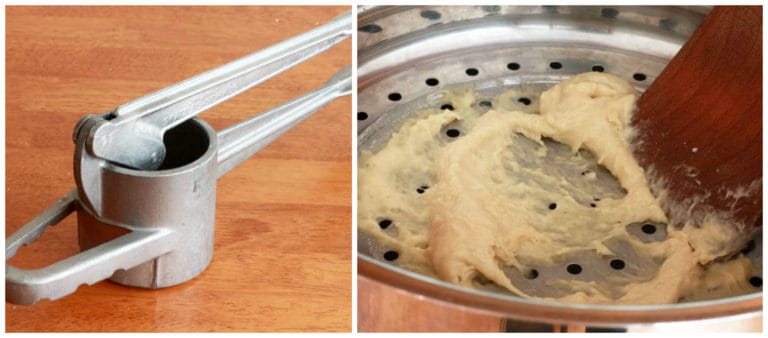
My personal favorite is the Spätzle press and that’s what I’m using in the pictures below. Place the Spaetzle maker over a pot of lightly salted simmering water and scoop some dough into it.
Press the Spätzle maker down to squeeze the Spätzle noodles out into the simmering water. Simmer the Spätzle for about 2-3 minutes or until they float to the top.
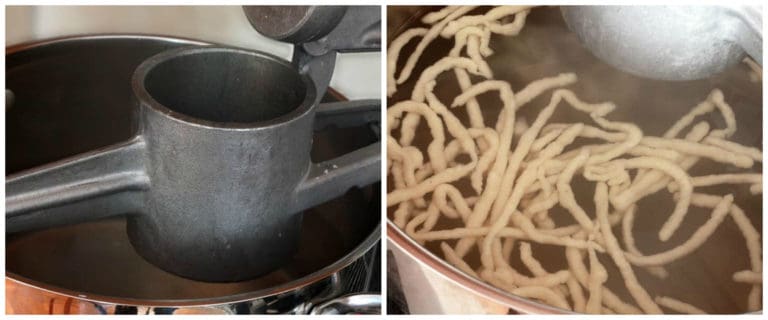
Using a slotted spoon, transfer the Spätzle to a colander and then immediately put them in a bowl of very cold water. This helps them firm up to the desired consistency.
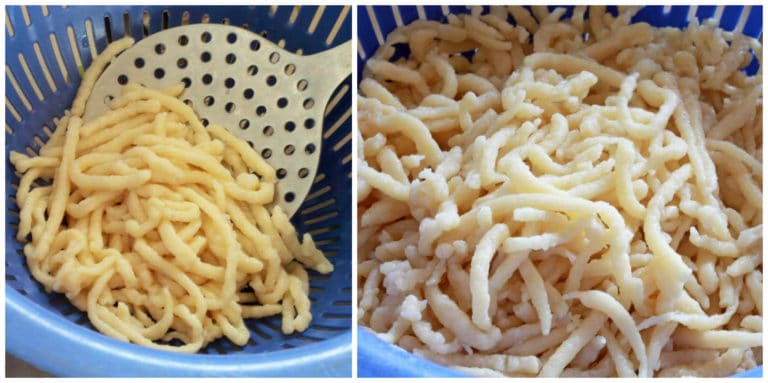
Drain the Spätzle again and toss with a little oil or melted butter to keep them from sticking.
Spätzle will keep in the fridge for at least a couple of days and then heated to serve. Melt some butter in a pan and toss the Spaetzle in it to warm through.
Storage & Freezing
Spaetzle can be made in advance, cooled, and stored in a covered container in the fridge where it will keep for 3-4 days. To reheat it you can microwave it in a microwave-safe container or, my favorite way, is to melt some butter in a large skillet, add the Spätzle and heat through. Spaetzle also freezes well for up 3 months: put it in a freezer-safe container and let it thaw overnight in the fridge. It can be reheated in the microwave in a covered container so that it doesn’t dry out, or you can melt some butter in a pan and toss the Spaetzle in it until warmed through.
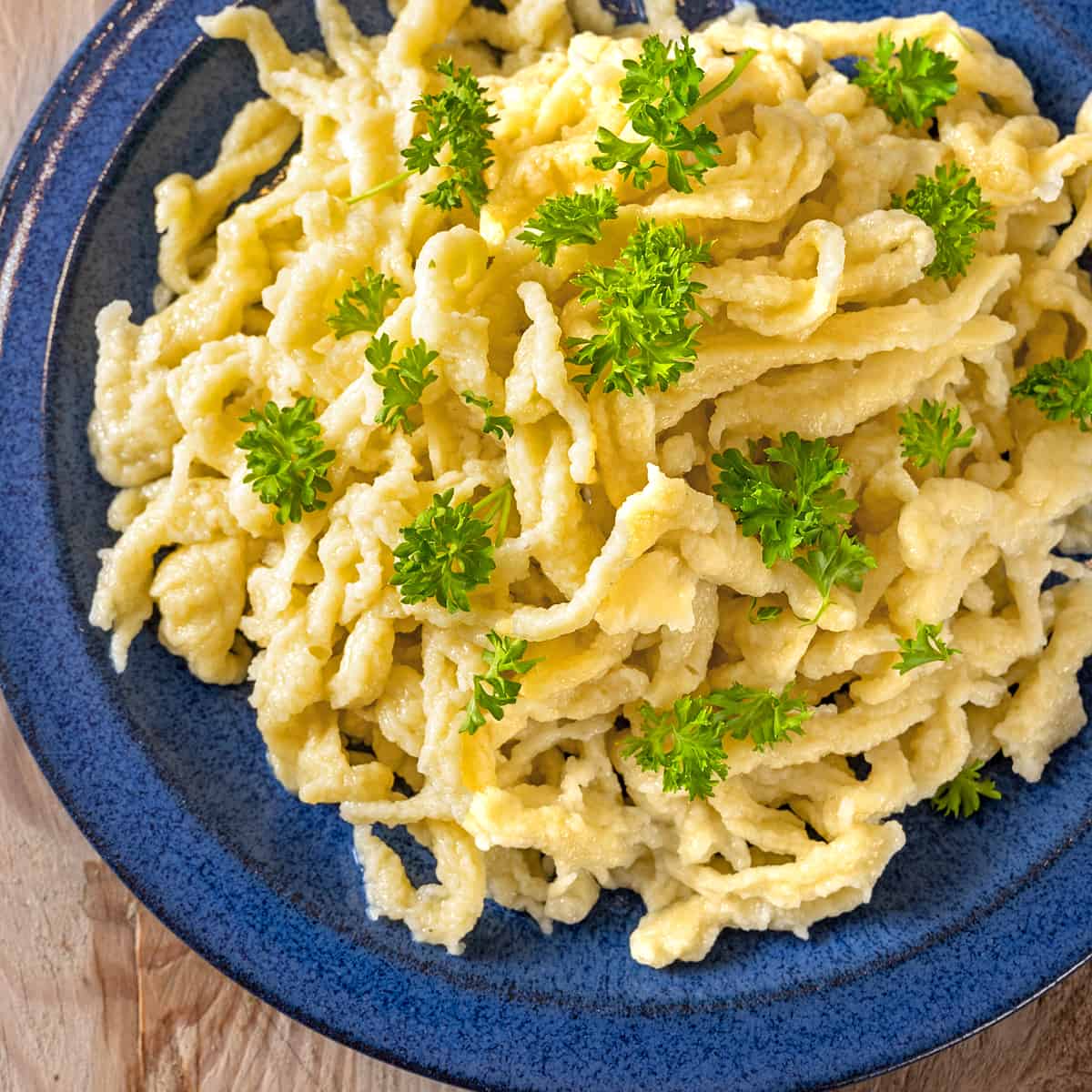
What to Serve with Spaetzle
Spaetzle is very versatile and can be served a variety of ways. Here are a ways to serve spaetzle:
- Buttered Spätzle: This is one of the simplest and most traditional ways to serve spaetzle. After boiling and draining the cooked spaetzle, toss them with melted butter and sprinkle with chopped parsley.
- German Cheese Spaetzle (Käsespätzle): Another Swabian classic and personal favorite, try my recipe for Käsespätzle (pictured below).
- With Sauces and Gravies: Spaetzle can be served with any sauce or gravy, like my favorite German Rahm Sauce, Onion Gravy, or Mushroom Gravy. Serve it with my classic German Goulash, Geschnetzeltes or Königsberger Klopse.
- With Meat Dishes: Spaetzle is the perfect choice to serve with any saucy meat dish like Jagerschnitzel, Rouladen, Sauerbraten, Pot Roast and Tri Tip Roast. It can also accompany your Schweinshaxe and Frikadellen.
- Pasta Salads: For a variation on traditional pasta salad, toss the spaetzle with fresh vegetables, herbs, a vinaigrette, and some diced cheese and ham.
- In Soups: In some regions, spaetzle is added to soups, much like dumplings. Drop small portions of spaetzle dough directly into simmering soup and let them cook until they float to the surface as in this Gaisburger Marsch and German Pea Soup.
Guten Appetit!
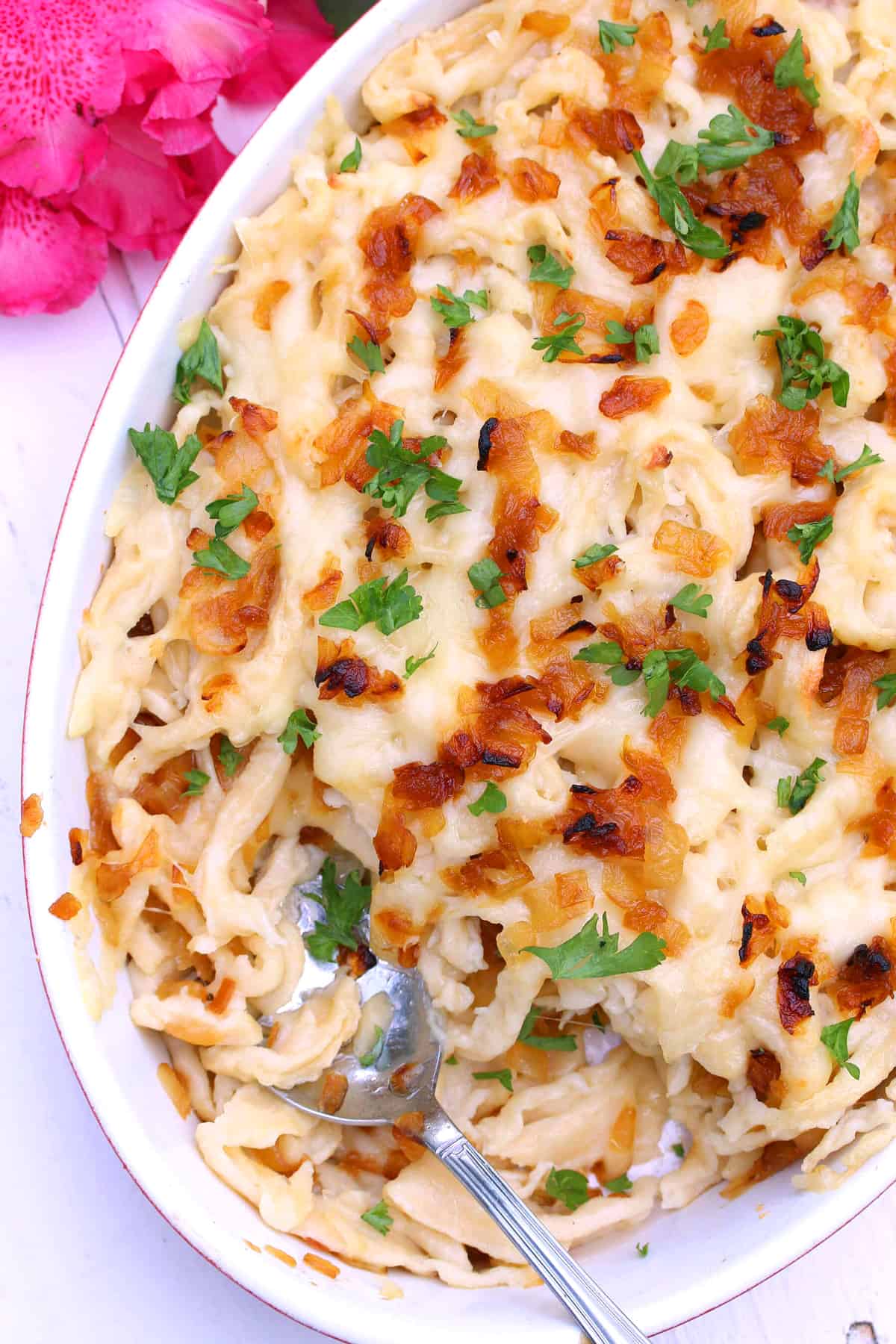
For more favorite traditional German dishes be sure to try my:
- Kaesespaetzle
- Rouladen
- Sauerbraten
- German Goulash
- Maultaschen
- Schnitzel
- Bread Dumplings
- German Potato Dumplings
- Zwiebelkuchen
- German Bread (Vollkornbrot)
- Bratwurst
- Currywurst
- German Potato Salad
- Rotkohl
Save This Recipe
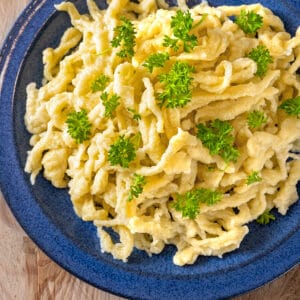
Traditional German Spaetzle Recipe
Equipment
Ingredients
- 2 cups all-purpose flour (you can also use whole wheat flour)
- 1 1/2 teaspoons salt
- 1/8 teaspoon freshly ground nutmeg , optional (not traditional but adds a nice flavor)
- 4 large eggs
- 1/2 cup milk or water + more as needed (milk produces a richer Spaetzle) (**add more flour if the dough is too runny, add more milk or water if it's too stiff)
- butter for serving
Instructions
- The Spätzle batter can be mixed by hand or by using a stand mixer which is much easier. Add the flour, salt and nutmeg (if using) to the bowl of a stand mixer. Stir to combine. Crack the eggs into a small bowl and whisk them. Make a well in the center of the flour mixture and pour the eggs in it. Add the milk (start with using slightly less and add more as needed). Attach a paddle attachment to the stand mixer and "knead" the dough for about 10 minutes or until bubbles appear (see pictured instructions for details). After 10 minutes or so of beating, use a wooden spoon to scoop and pull the dough. If bubbles/holes appear, the dough is done
- Bring at least 2 quarts of lightly salted water to a boil, then reduce to a simmer. Using a Spätzle maker of your choice (I use and prefer the Spätzle press), press the noodles into the simmering water and cook for about 2-3 minutes, or until the noodles float to the top. Use a slotted spoon to transfer the noodles to a colander to drain the hot water and then to large bowl of ice water (this firms them up for a better/chewier texture). After a minute or two transfer them to a colander to drain completely. Before serving, warm them through in a skillet with some melted butter.
- Make Ahead: The Spaetzle can be stored in the fridge for at least a couple of days and then reheated. Melt some butter in a large skillet and toss the Spätzle in it to heat through. Alternatively they can be microwaved in a covered dish.
Notes
Nutrition
Originally published on The Daring Gourmet on August 3, 2013



















I toss my spaetzle with butter and emmentaler or gruyere cheese and it is far better than these silly american mac and cheese! Please post a recipe for Kartoffelsalat if you get a chance!
Hi Win, YES! In fact, that reminds me – I need to post my recipe for Käsespätzle. Spätzle with butter and tons of Emmentaler or Gruyere, topped with tons of buttery caramelized onions, and baked. One of my all-time favorites!
And you’re in luck – I just posted my Schwäbischer Kartoffelsalat! Be sure to subscribe to this blog (very top right of the screen) so you get an email notification when new recipes are posted (those are the only times you’ll get things in your mailbox from this site, I promise!).
Was recently in Germany and spent all of my time in the Swabia Region. You are correct is saying the that food is wonderful there. Everywhere we visited we were served that fabulous German Potato Salad. No it wasn’t hot and no it did not have bacon in it. Each time we had it it tasted the same – just plain good. I have searched the internet for this salad and nothing I found matches the taste. If you have a recipe for that salad, I would love if you could share it.
I love, love, LOVE Schwäbischer Kartoffelsalat! As much as I enjoy the kind with mayonnaise, the Swabian-style potato salad is my favorite and there are definitely some tips and tricks involved to get it “right” – like that kind you enjoy in German restaurants. Teri, I would love nothing more than to oblige your request! :) Stay tuned!
thanks for all the great information – and pictures!
just confused by one one thing, the step by step directions say to use 4 eggs, and the recipe says to use 3
thanks and merry Christmas!
Arnette
Thank you for catching that! I’ve updated the recipe box – yes, it’s 4 eggs. A very merry Christmas to you, too! -Kimberly
Can I make this dough ahead?
Hi Roxanna! The dough needs to be room temperature otherwise it won’t turn out. I’ve never heard of it being able to be made ahead and wouldn’t recommend that. What you can do though, and this is very commonly done, is to make the Spätzle itself ahead of time (up to a couple of days) and then simply reheat the noodles. The best way to do that is to melt some butter in a pan and then toss the noodles in it. They’ll turn out perfectly that way.
If you make dough in advance the proteins in the flour change, desirable for breads/pastries, but for this makes everything texturally wrong and ‘gluey’, make, refresh and freeze spread on a tray to keep them separate,bag them up and reheat as fresh. I personally like them fried til crispy. Great recipe by the way DG!!
Thanks for the tips, Ben, and I’m glad you enjoyed the recipe! I agree, I’ve never made Spätzle dough in advance and wouldn’t recommend it either. Great tip on freezing the finished Spätzle.
I make them according to the recipe above – and freeze them in portions. To reheat, I fry them in butter until golden, so delicious ! Perfect side dish.
great recipe and love the pictures!! My parents are from Ludwigsburg, and we always made home-made spaetzle (long like spagehetti).
Hi, Suzanne, and welcome! No kidding? I lived in Ludwigsburg for several years and loved it. Thanks so much for the compliment and I hope you’ll return here often.
This is great! Thank you!!
Thank YOU!
My heritage is Hungarian and I’ve always made haluska (very similar to spätzle) – by hand. The only ingredients are eggs, flour & a little salt, and I never measure anything when making them. It’s nice to have a recipe for genuine spätle.
Yes, haluska! I remember when I was in Hungary an older woman making Hungarian egg noodles. She would take a wad of dough into her hands and with quick, swift motions pinch off little chunks of it into the simmering water. Many Hungarians still make it this way. It’s similar in appearance to German Knöpfle (Spätzle “buttons”) which are made using the same dough but are instead grated across a board with large holes in it resulting in little chubby “button” noodles. Like the Hungarian noodles, some Spätzle recipes don’t milk or water, but use several more eggs instead which yields a richer, firmer texture.
You enjoy a beautiful heritage! I love Hungary, it’s food and it’s people. Thanks for visiting and for you comments.
Slovenian here. I make dough water, flour egg, its soupy, then sticky thick. use a tsp spoon, dip in batter , put in boiling water. they sink, then float to top when done. never heard of pinch dough. put water. that dough must be more flour, thick.
what is BEST flour these days? so many kinds, gluten, non gluten bleached, unbleached, and getting disaster results w gluten free! all purpose gluten wheat, unbleached?? Bleached is full chemicals, ugh!
Hi, I use regular all-purpose unbleached flour. (Definitely not gluten-free, yes it will be disastrous!)
I am gluten free and had to do without my favorite for years. Then I discovered Bob’s Red Mill gluten free flour. My family was skeptical but it was perfect! So happy I can have my favorite meal again!
My Heart leapt for joy when I saw this…. Will be trying very soon.
Stay tuned for a follow-up post that will feature a sauce to go with the Spätzle!
Saute with butter and bacon. Start with the butter on high heat, saute shallots, garlic and mushrooms. Add spaetzle and cook until it crips. Deglaze with more butter and add veg (spinach, or whatever). Tested and true.
FABULOUS!! Thank you, Andrew!
I have my great grandmother’s spaetzle maker, it’s still amazing today. I also swaebishe kuchbuch if you would like me to share with you.
That is such a treasure, Kamala. Those are the kinds of possessions I value most.
I would love if you shared tour cookbook with me. YUM!!!
Is there a way to make spaetzle without the spaetzle maker?
There are several ways you can make Spätzle and I outline those in my post – several different gadgets as well as using a cutting board and sharp knife.
I made this today for supper and it is amazingly easy to make in the stand mixer. I served it with German sausage, and German red cabbage. DELICIOUS! Thanks Kimberly@TheDaringGourmet :-D
Thank YOU, Wendy, I’m so glad you enjoyed it!
My mother used to make potato soup and the thing I liked best was the spaetzle she dropped into it. I can’t find a recipe (she didn’t write things down), but I seemed to remember her rolling little spaetzles in her hands and dropping into the soup. Does this sound at all familiar?
Hi Nancy, the first dish that comes to my mind that famously combines potatoes and Spätzle is a soup called Gaisburger Marsch. It’s a very traditional German dish and has been around forever. Another traditional German soup that combines the two is this potato-pea soup with dumplings. It calls for Spätzle dough which is broken off in little mounds and dropped into the soup. Do either of these soups ring a bell?
Das anybody know how to make Gaiburge
Hi, can you describe what that is?
Gaisburger Marsch right on, also those little noodles/dumplins are called Schupfnudeln AKA “Bubaspitzle AKA more to the point “Bauraseckele” in the Schwaben Land !Just wanted to share !
Kimberly, do you know if it’s possible to make the batter, keep it in the fridge overnight and then press the noodles into the boiling water the following day ?
Hi Eric, that should be just fine. I would just let it return to room temp before squeezing it through the press otherwise it may be a little too firm.
Please, we have a package of this and no instructions as to how to cook it. Can you help us?
Hi BettyAnn, you cook it the same way you would cook regular pasta – dump it into boiling water and cook until done, slightly al dente.
My Slovenian grandma recipe was just 3/4 flour, 1/3 water, 1 egg. Lately flours have changed so much, and having disaster results w soupy texture, falls apart in boiling pot, etc. Since gluten free, gmo there is problems in texture!. gluten free flour is not working. need elasticity for spatzle. bleached, unbleached? think unbleached, no chemicals! any input? think only wheat flour all purpose is best…
King Arthur was big fail, both G-free. Organic. HELP!
Hi Lorene, no special flours are necessary – just plain, regular all-purpose unbleached wheat flour.
I haven’t tasted spaetzle this good since I lived in Germany. Great recipe, thank you!
Wonderful, Tammy, thank you!